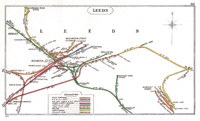Leeds Central and its workings

The station nameboard c1960 and one of the station pilots in 1963.
There used to be two main line stations - Leeds City (previously called "Leeds New") and Leeds Central and it is the latter I shall be looking at here. Perhaps because I spent many a Saturday there... The service covered GNML expresses to King's Cross and via Harrogate to Newcastle and Glasgow, as well as the secondary services in the West Riding. I already have several related topics and it's going to be hard to avoid some overlap. This topic covers:
1 - General views 2 - Station pilots 3 - Secondary services Leeds-KX
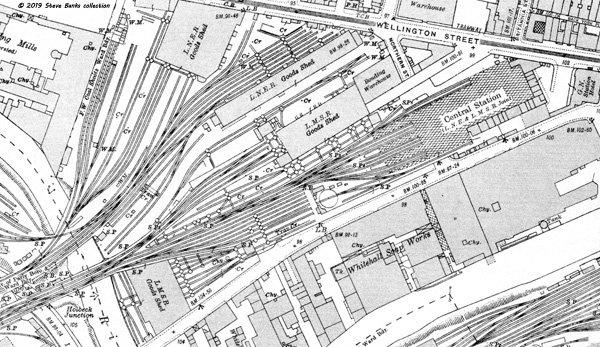
The OS map of 1932-36 showing Leeds Central station and surrounding goods facilities. Note how compact the passenger station was and how vast were the goods facilities provided by the GNR, NER, LYR, LNWR and MR companies. The main approach from the city was via Wellington Street on which the Great Northern Hotel was also placed. Part of the railway access can be seen in the LH corner, the lower tracks from Copley Hill and the upper ones, Gelderd Junction for the NE. Source: National Library of Scotland.
Click on the image for an enlargement
1 - General views
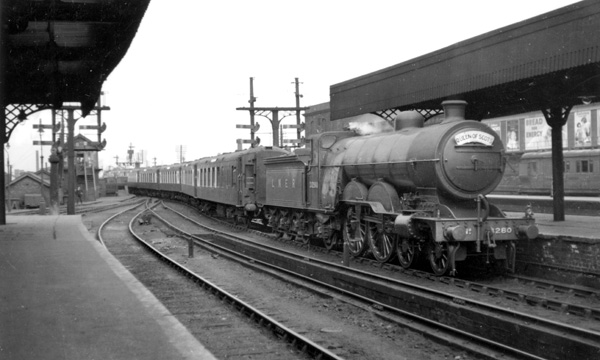
Looking out of the station in the 1930s. In the left middle distance, sidings lead to a small goods yard. The station signal box is further back. The under-slung signals were a feature of the station, to give good visibility along the whole length of the platforms, and at this stage they were still ex-GNR somersaults. In between each of the platform faces there was a third road, with an inspection pit. It could be used to store stock, or allow a train engine to be released and run round the carriages to proceed to the engine shed at Copley Hill (the depot will be a separate subject).
Large Ivatt Atlantic C1 No 3280 had brought the 7-car "Queen of Scots" Pullman in from King's Cross and, having given the departure for Glasgow a helpful push, is now dropping back. The loco at the head cannot be identified but would probably have been a Raven C7 Atlantic. This C1 was at Copley Hill between 1932-36. Photo: SLS.
Click on the image for an enlargement

An unusual picture taken from underneath the station signal box shows A3 60105 Victor Wild departing into a midday or early afternoon sun. My apologies for some motion blur but it is an interesting picture.
The livery is hard to see because of the sun angle and a layer of grime. The loco had passed through Doncaster Works in February 1953 when it was converted to LH drive and received BR dark green livery. It was a Grantham loco at the time and the date of this picture is thus estimated as early/mid-1950s.
A puzzle concerns the carriage behind the tender for the beading is GER-style! Alas no more of the train is visible so it's not possible to offer any more detail nor what the working may have been, although a possibility is a return of a secondary service from Doncaster for which a variety of old carriages was deployed and for which visiting locos were often borrowed.
With thanks to John Smart for spotting my typos and misreading of RCTS 2A and the carriage. Photo: Author's collection.
Click on the image for an enlargement
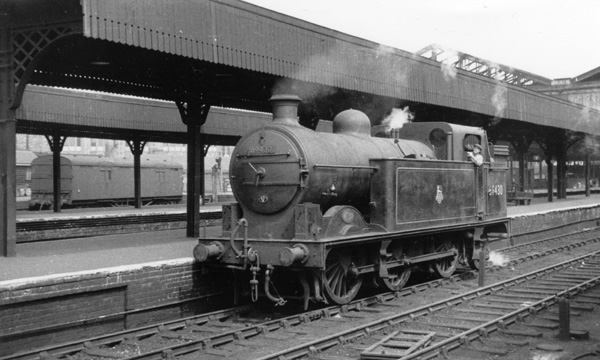
A 1956 view across most of the platforms with a bogie CCT in the parcels bay. Copley Hill's N1 No 69430 seems to be drifting by after having worked in with a local train, and the crew have forgotten to place a light on this end of the loco. Photo: R.S. Carpenter.
Click on the image for an enlargement
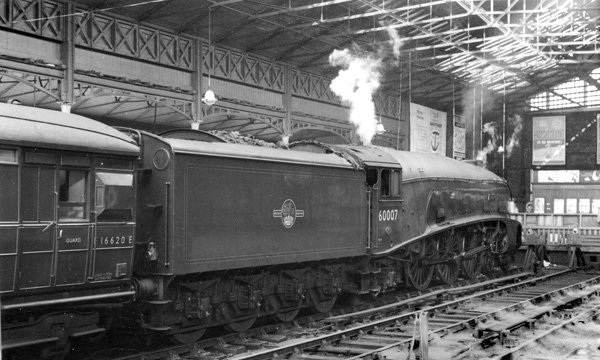
A4 No 60007 Sir Nigel Gresley stands at the buffers after arriving with an express from King's Cross. Beyond is the station concourse. The overall roof extended half way up the platforms. 25th February 1960. Photo: G.W. Morrison.
Click on the image for an enlargement
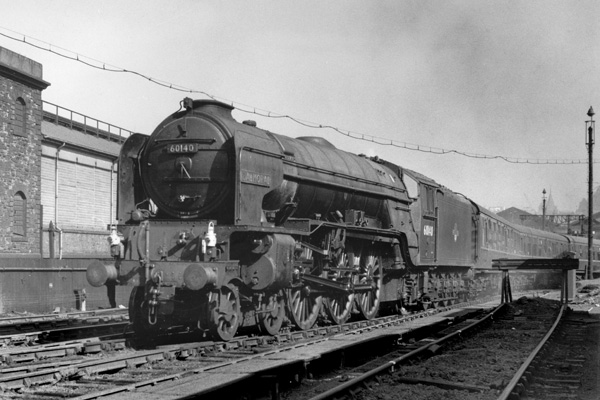
A classic view from the BR era as Peppercorn A1 No 60140 Balmoral departs with the 12.30pm West Riding Express to King's Cross. The Ripon & Harrogate portion had already been attached and the one from Bradford would be added at Wakefield. Appearance of Balmoral, a York loco most of its working life, was unusual. March 1961. Photo: G.W. Morrison.
Click on the image for an enlargement

The transition from overall roof to awnings along the platforms shows well here, and the sidings on the northern side of the station where parcels traffic was handled. Thompson L1 No 67742, presumably borrowed from Ardsley, is acting as station pilot and drawing away two Pullman cars. These are the two strengtheners to the "Queen of Scots". An English Electric Type 4 (later Class 40) had brought the train in and waits at the buffers. The date on the print claims "Saturday 28th September 1963" but this cannot be right as it's almost a year after this loco was withdrawn (15-12-62). Photo: E.G. Pearson.
Click on the image for an enlargement

Many years later a view from the western platform shows the massive LMS goods warehouse adjacent to the station. Fairburn 2-6-4T No 42052 pulls out with the empty stock of an express for the carriage shed and sidings at Copley Hill. They were not normally used as pilots. January 1965. Photo: Author.
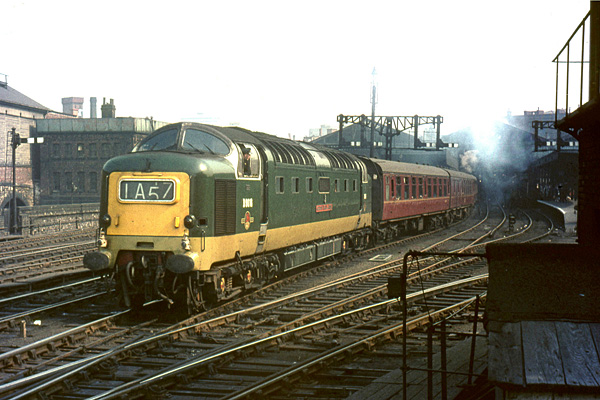
The station throat seen from below the signal box. Deltic D9016 Gordon Highlander is in charge of a West Riding expres - IE10, the 12.14pm Leeds Central-King's Cross. Carriages from Bradford will be attached en route at Wakefield. However, the roller blind has failed; it was quite a common occurrence and it is displaying a previous working: a Newcastle-KX express. As a result, double lights per the Express code are being carried, one over each buffer. 1965. Photo: Author.

And finally, looking out from the station throat as B1 61259 A.Harold Bibby coasts down the gradient with its safety valves blowing off and a four-coach express, the daily working from Grimsby. To the right are the goods lines into into the considerable goods warehouses. January 1965. Photo: Author.
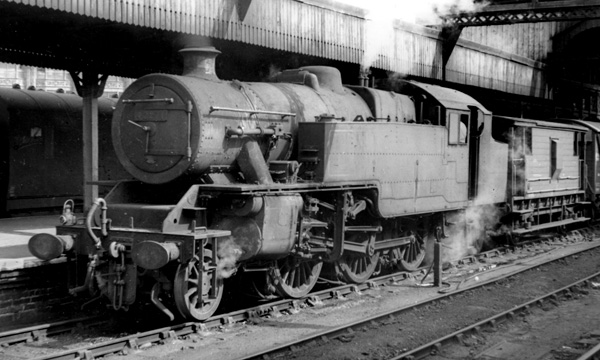
By the mid-sixties ex-LMS 2-6-4 tanks were increasingly being allocated to former GNR sheds in the West Riding. However, Fairburn No 42271 was a Holbeck loco and it's standing with an ex-LMS goods brake van and what looks like some vanfits, perhaps not so much a goods train as a parcels working. There was also traffic out of Leeds Central, originally a joint station, onto the former LYR and LNWR lines. 13th August 1965. Photo: Author's collection.
Click on the image for an enlargement

A fine sight at the station throat as Fairburn 2-6-4T No 42074 gets away with the shortest possible parcels train, an ex-LMS 50ft BG. The loco had only recently been transferred from Bangor in North Wales and a new shed plate had yet to be attached (it ended up at Low Moor). 22nd September 1965. Photo: Author's collection.
Click on the image for an enlargement
2 - The station pilots
From GNR days, half a dozen J50 tanks were based at Copley Hill to act as pilots - at Leeds Central, Wellington Street Goods, the carriage sidings at Copley Hill and around the engine shed. By 1960 a quartet was left in charge. Construction had taken place from 1913-1939 and there were four variations, classed J50/1 - J50/4. The main visible difference was in the bunker.
J50/1 No 68892

Updated caption - J50/1 No 68892 was the oldest J50 to serve at Copley Hill in BR days (it had been built by the GNR in 1914) and, ironically, was to be the longest serving of all. It was moved around quite a lot and, as seen in this picture - where it is carrying a 51E shed plate - it was at Thornaby until June 1959, when it was transferred to Hull Botanic Gardens, and from there in September of that year, to Copley Hill. It was the last J50 to be withdrawn from the Leeds shed in September 1963. Photo: Author's collection.
Click on the image for an enlargement

A view of J50/1 No 68896 in the shed yard at Annesley in 1958 is useful for showing the short bunker on this early design and the tall extension above it. Photo: Author's collection.
J50/2 Nos 68911, 68925
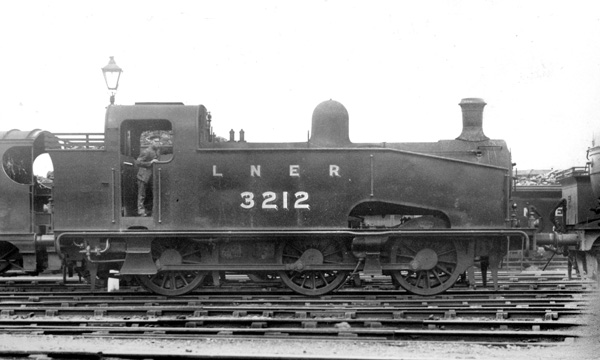
J50 tanks were at Copley Hill from GNR days and more were added by the LNER, but illustrations are hard to find. This is J50/2 No 3212 (built 1919) at Doncaster in 1930. It was transferred to Copley Hill a few years later and served through BR days as No 68911. It became a relatively early casualty when it was withdrawn in November 1960, only to be transferred into Departmental Stock where it served until May 1965. Photo: Author's collection.
Click on the image for an enlargement
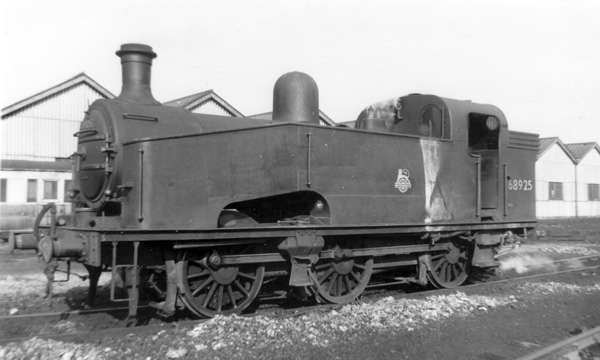
Another example of the second GNR-built variation is seen in the shed yard at Copley Hill in the 1950s. The plate appears to be being replaced, the designation changing around this time from 37B to 56C. Photo: K. Swain.
Click on the image for an enlargement

The same loco seen in 1959, now with a 56C shed plate, stands (according to the photographer) at Copley Hill with the corridor tender of an A4 ahead of it. I wonder if the location was actually Doncaster Works? Photo: R.W. Hinton.
Click on the image for an enlargement
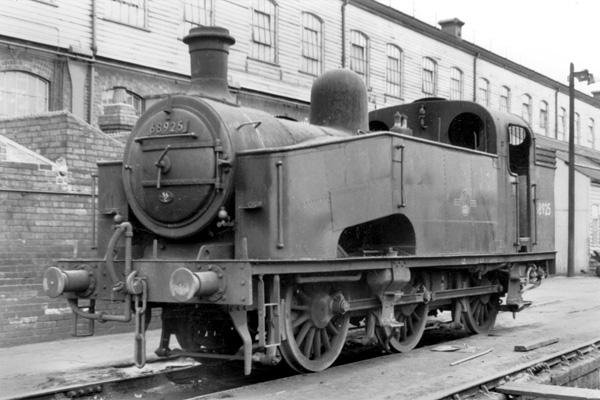
J50/3 No 68925 was one of the longest stayers at Copley Hill and is seen c1960 at Doncaster Works. Photo: Author's collection.
Click on the image for an enlargement

This picture of the same loco was taken at Copley Hill in March 1963, at the west end of the shed standing in front of 68984 or 68988. It was the last month of service for this trio. Photo: Author's collection.
Click on the image for an enlargement
J50/4 Nos 68984, 68988

The final batch of LNER-built J50s was delivered in 1938-39 and featured a commodious hopper-style bunker. Here is No 68984 at work at Copley Hill Carriage Sidings in 1961. Photo: Author's collection.
Click on the image for an enlargement
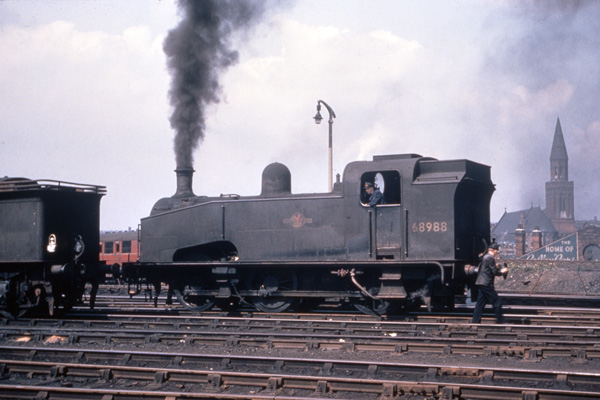
This time it's 68988, on the same duty at the same location. August 1961. Photo: Colour-Rail BRE225.
Click on the image for an enlargement
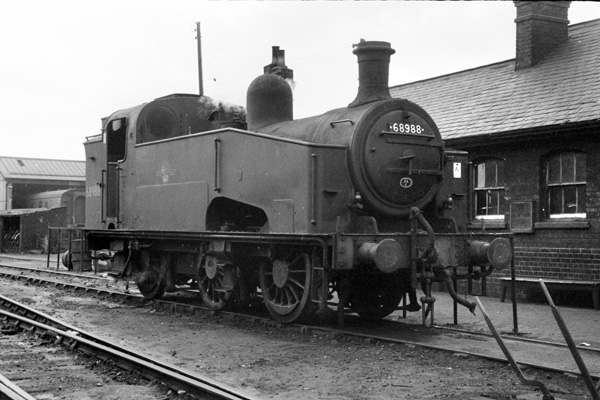
A slightly later view of No 68988 parked in front of the offices at Copley Hill. This was a common place to leave a pilot when it was not required. Spring 1963. Photo: Author.
Click on the image for an enlargement

Before leaving the J50s, here's a model that I made a great many years ago of everybody's favourite, 68988. At the time, all that was available was a K's kit for the J50/3 (same bunker as J50/2) but I reworked that part, adding other details along the way. I even commissioned the smokebox door number and shed plate. But I was too young to build a proper chassis, please don't look too closely! It's just a memento, really. :)
Other tank engines
After the J50s were withdrawn, in 1963, the duties were taken over by B1 4-6-0s, but there were some interludes with other types.
.
In 1963 when Scarborough and Malton sheds closed to steam, their Riddles 82xxx 2-6-2Ts, Nos 82026-29, were dispersed. They all ended up at Guildford but, along the way, No 82026 was tried at Copley Hill for a short while and is seen here at the carriage sidings. Photo: Author.
Click on the image for an enlargement
3 - Secondary services to KX
Secondary services between Leeds-KX tend not to be "seen" even though they were important as intermediate services and used to convey non-passenger stock along the GNML.
7.8am Leeds Central-KX
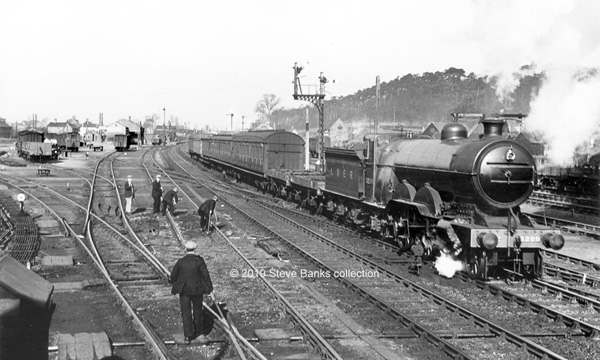
This picture, taken at an unknown date in the early '30s shows the all-stations 7.8am from Leeds Central (9.00am from Doncaster) departing Sandy approximately 2.45pm, King's Cross arr. 5.1pm. A Copley Hill loco would have taken the train to Doncaster where Ivatt Atlantic C1 No 3289 (New England) took over and is seen here.
The formation is very secondary and based on ex-GNR carriages, many 6w. Such formations were prone to variation and the passenger carriages seen here are:
BCL |
1st/3rd brake |
ex-GNR 58'1 1/2" |
From Leeds |
BT-CL |
1st/3rd brake |
ex-GNR (ex-6w twin) |
" |
B |
brake van |
ex-GNR 6w |
" |
-------- |
------------------- |
----------------------------- |
------------------------ |
TO |
3rd open |
ex-GCR Barnum |
From Doncaster? |
BV |
brake van |
ex-GNR 45' |
From Doncaster |
Unfortunately the camera was jarred at the moment of exposure which has given rise to a doubling of horizontal lines and made analysis of details difficult. One of the carriages in the photograph is a fresh-looking ex-GCR TO "Barnum" (some were based at Cambridge and this may have been an ECS delivery after shopping) or a strengthener from Doncaster. Photo: anonymous, author's collection.
Corrected and expanded
Secondary services on the GNML were much used for conveying all sorts and it turns out that what I thought were two goods wagons behind the tender were in fact ex-GNR Open Carriage Trucks (OCT). It is, however, a little complicated!
Ex-GNR Open Carriage Trucks (OCT)
Here is an enlargement of the train, shaken by the photographer as already described:
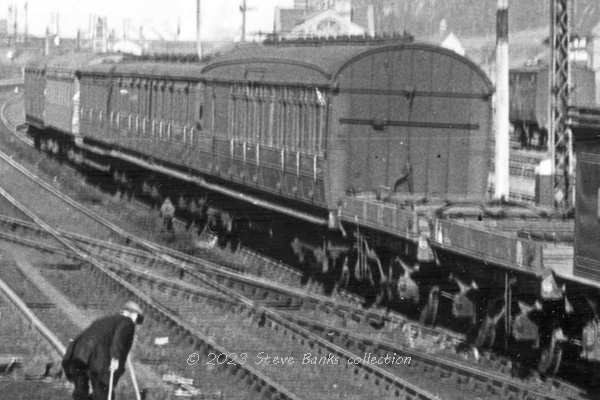
Click on the image for an enlargement
Details of the OCTs are hard to ascertain. Terry Henderson covered the type in one of his superb compilations for the GNRS with the dwg from Diagram 375 and two as-built photos, and Peter Tatlow showed one of the same photos and a pair of modellers' drawings. What isn't really covered is that there were two types with different lengths and capacities, and that one of them was rebuilt with a longer WB.
This is the RH page of the GNR Diagram and its drawing:
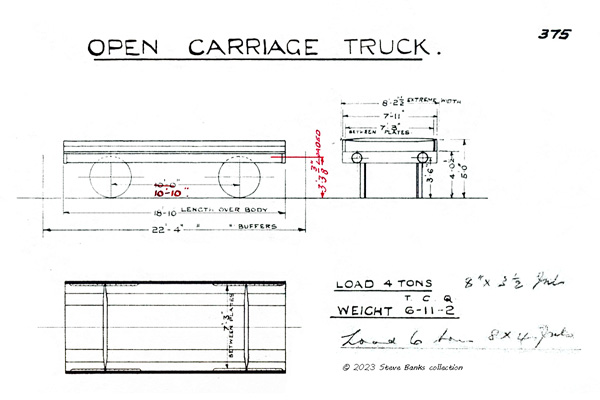
Click on the image for an enlargement
The pencil notes are almost invisibly faint and I have Photoshopped them for clairity. They appear to say:
LOAD 4 TONS 8" x 3 1/2 Jnls ("Jnls" = Journals) and: Load 6 tons 8 x 4 Jnls
Which comes across as a belated attempt to distinguish between the two types combined on the same Diagram. As regards the red ink extension to the wheelbase, it looks like it was for the 4T version - one of the photos shows a longer WB on the 6T version and by combining all the info I conclude the following:
Load |
Length |
Wheelbase |
4T |
18'10" |
10'0" * |
6T |
21'0" |
12'6" |
* 10' WB later extended to 10'10"
The table of details on the LH page of the Diagram is much amended and unclear and I lack the time to resolve it. A key point re GN.375 concerns the numbers built for as far as I can tell they were:
4T 89 6T 9
Of which, according to TH, the majority received LNER numbers but also carry his note of "To LNE Van No.453 (etc)". It is not clear what this note means. It may mean that the LNER running number was placed in the LNER carrriage's van series (used for NPCS) which meant that the same running number could appear in both passenger and NPCS categories, rather than a rebuild from OCT to some kind of van. According to Peter, GN.375 dates from "1890" and Terry shows 29 gaps, which suggests LNER withdrawal at some point of almost a third of these OCTs but no withdrawal dates are available. Of the nine built to carry 6T, eight have this note and I presume ran into LNER days.
I might mention that there were several other versions of OCT including one on bogies; two 6w; and a 4w version with a well. In other words, there was a substantial fleet of them. My guess is that farm machinery and assorted horse drawn vehicles may have been a common load.
The OCTs in the photograph at Sandy can be recognised by the short manual brake levers as a pair of the later 6T 21ft types. One is facing in the opposite direction, indicating that a reversing knuckle had not been fitted and both levers were at the same end. They were not permanently coupled in pairs, the photograph merely shows two of them travelling empty together.
Later developments of the 7.8am
Over the years this train was gradually modernised and expanded and the rosters for two later years show:
1934
BCL, TK, C, BV
from Leeds which was a passenger 3-set with a single gangwayed carriage and a Howlden bogie van, but on the day of the photo at Sandy, perhaps earlier, it was more primitive. A van was added at Doncaster (6w) as well as (SO) 6w passenger strengtheners from there and Peterborough so what had started as a passenger 3-set could roll into King's Cross with 8 assorted carriages, many of them 6w and many of them vans. It's very much how secondary services were worked on the GNML.
1939
From Leeds as before, but growing to a maximum of 9 carriages during its journey with more gangwayed stock and BGs but two 6w carriages were still included. I have other photographs of this service behind K3s showing a passenger 3-set and a lot of vans but that needs a new topic really.
Click on the image for an enlargement
Links to other aspects:
Copley Hill engine shed: is here.

